In January of 1915, Hubert Fassbender’s cheese factories in the Town of Ellington, Outagamie County, Wisconsin, were running at full capacity. His wife Anna was about four months pregnant with their fourth child, their first-born, a son they named Clemens, was born on August 10, 1904, but sadly passed away just eight days later, and was buried in the St. Mary of the Immaculate Conception Cemetery in Greenville. Living at home were eight-year-old Mabel, born May 24, 1906, and five-year-old Gertrude, born July 28, 1909.
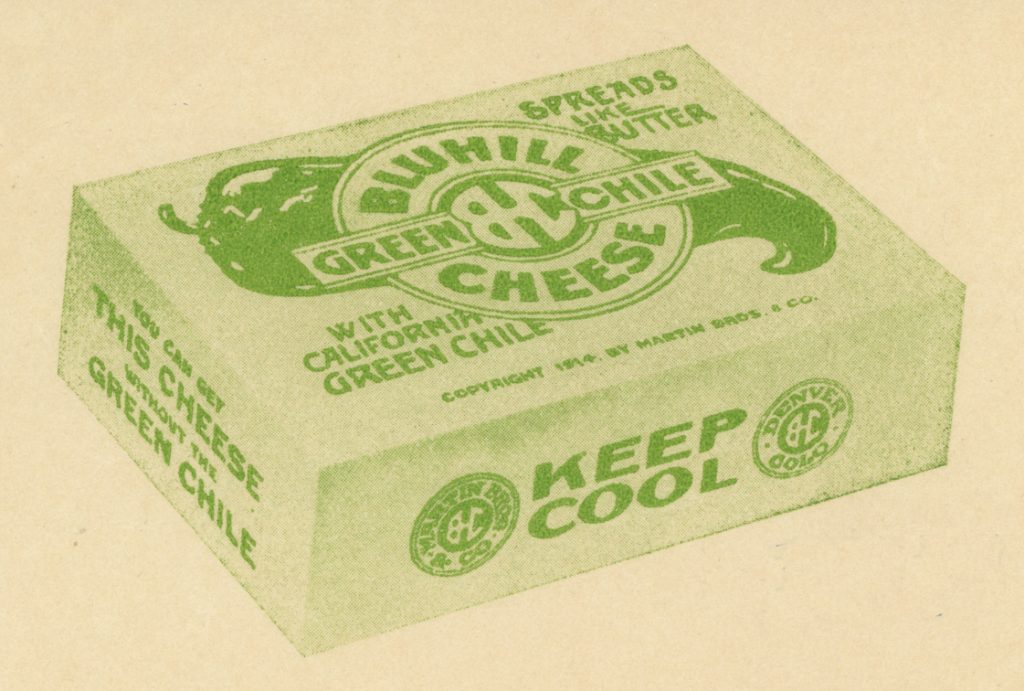
It was around this time that Hubert was approached with a business proposition. He met with Appleton resident John L. Jacquot whom he had known for several years. Jacquot who had moved to Appleton in 1903,1 owned and operated a cold storage and distribution depot on College Avenue, which moved local cheese all over the country. At the Jacquot facility in 1910, the first “Big Cheese,” a 4,000-pound American cheese, was constructed for the National Dairy Show, held in Chicago, from October 20th through the 29th.2
Hubert was invited to join Jacquot, who had partnered with the Ingersoll Packing Company of Ottawa, Canada, and the Martin Brothers and Company of Denver, Colorado in a new business venture, the business to be called The Bluhill Cheese Company would manufacture Anona Cheese for distribution west of the Mississippi.
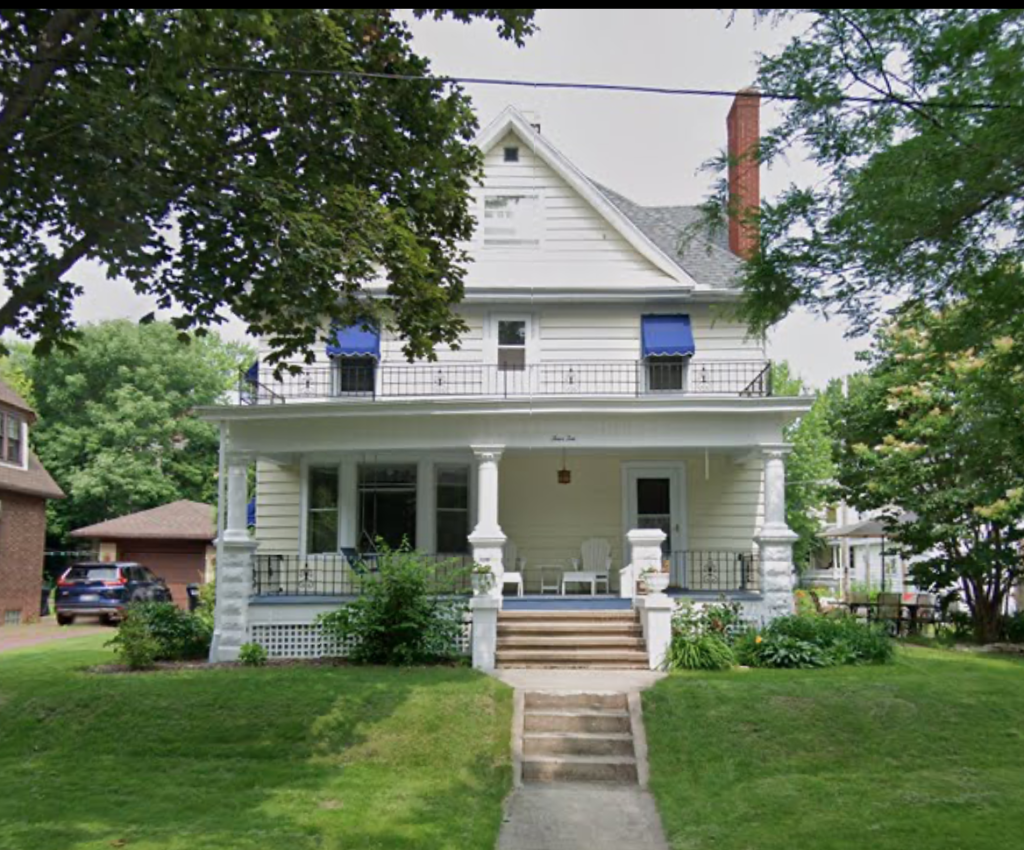
In preparation for this new phase in life, on March 20, 1915, Hubert purchased a home in Appleton on Prospect Street from Flank Slattery.3 The home which was located at 930 Prospect Street, was renumbered in 1925 to its current address, 410 West Prospect Avenue. Hubert would live in this home until his death in 1947, and it was here that he and Anna welcomed their son, Hubert Peter, on July 27, 1915.
Six days before to the birth of his son, on July 21st, Hubert joined John Jacquot and Fred V. Heinemann in the office of George T. Richard at the Outagamie Loan and Title Co. to execute the new firm’s Articles of Organization.4
Two days later on July 29th, The BluHill Cheese Company, was incorporated with a capital stock of $30,000, three stockholders, and three hundred shares valued at one hundred dollars each. The stated purpose of the company was to “Manufacture, Buy, Sell, Store, Ship and deal in Cheese, Dairy Products and Food Products and to conduct such business incident thereto.”
The new company planned on opening on October 1st on West College Avenue next to John Jacquot’s cold storage facility at 1102 College Avenue.5 The building was just across Locust Street “where the Ruhsam Grocery store” was located. The address was 1086 College Avenue,6 and the building was situated on the west side of the block with College on the south, Richmond Street on the east, North Locust Street on the west, and West Washington Street on the north. Walgreens is currently (May 2023) the only building on this block, numbered 700 West College Avenue. The Ruhsam grocery building was to be the temporary location for the new company, as plans were being made for a new “factory, modern in every respect” which they planned to build in 1916.7
O. J. Ruhsam announced on August 18 that he had secured a new location, and Monday, August 23rd he would be open for business in the “old Maurer brick store at the corner of College avenue and Cherry street, near the C. & N. W. tracks.”8
While the newspaper does not announce the opening of the Bluhill plant, we can assume that it occurred on schedule as on December 10th an amendment to the articles of incorporation was filed, changing the name to the Anona Cheese Co., with C. C. L. Wilson of Ingersoll, Ontario, Canada as president, and J. L. Jacquot, secretary and treasurer.9
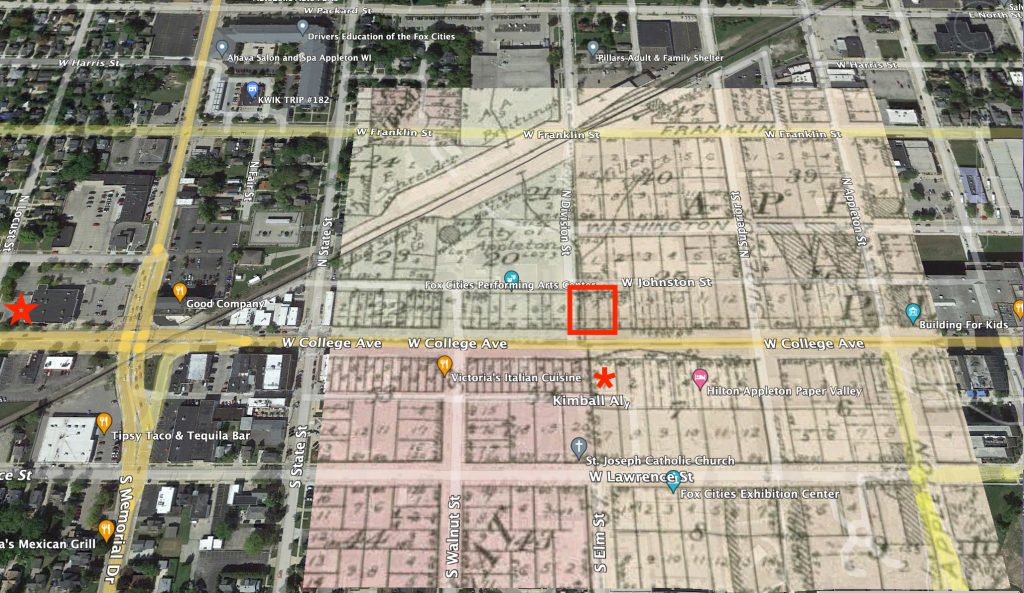
By January 1916 the factory was in full operation, and there was a curiosity about this new product that “looks like a cross between cheese and butter,” which “can be spread over bread the same as butter” with one “brand” containing green chili. “It is very appetizing, and from an economical standpoint is a good product. Butter at present is worth about thirty-eight cents, while [a pound of] Anona Cheese sell for ten and fifteen cents.” “One package of the Anona cheese would go as far as one pound of butter.”
The Appleton Evening Crescent reported that “Hobart [sic] Fassbender, Maker is Closely Guarded During the Mixing Process—Cream Cheese and Other Ingredients Unknown to Public Used in Manufacturing.” “…he is closely guarded, because be it known, he alone knows the process by which Anona Cheese is made, and his employers are very desirous that this knowledge remain where it belongs, in the factory on the west end of College avenue.”10
Hubert was “enclosed by a big cage of wood, within which he is again caged in a steel enclosure, where he does the mixing that produces the Anona cheese, made from the best cream cheese and other ingredients unknown to the public in general…the secret of the process remains with him alone. Day after day he enters the cage, works all alone and emerges after the day’s work, conversing with no one except at meal time and evenings. Lonely work, but important.”11
The cheese used in Anona cheese was all made in Outagamie County from “summer made cheese.” While there was no retail outlet for the cheese, a “number of local concerns” were selling the product which was first placed on the market the last week in December 1915.12
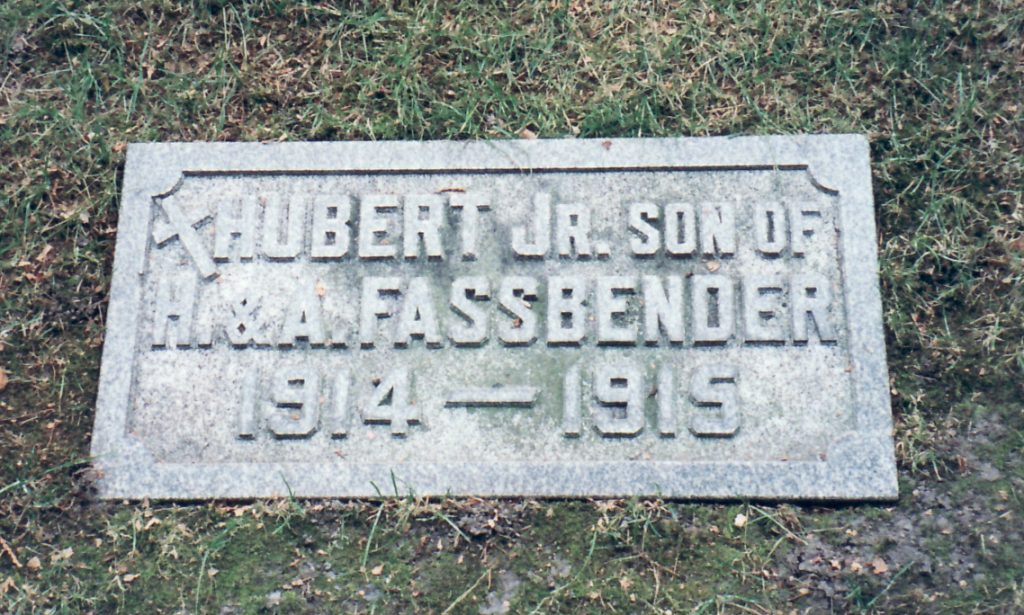
Wednesday, January 12, 1916, may have dawned bright but soon darkened. While working in the plant Hubert “suffered a broken arm when he was caught in a belt.”13 Arriving home after his arm had been set, he learned that his five-month-old son who had the flu, was not getting better.14 Hubert Peter Fassbender passed away that evening at 6:00 p.m., “after a severe attack of convulsions.” He was buried two days later on Friday in St. Joseph Catholic Cemetery.15
In May plans to build a state-of-the-art facility were well underway, with the Appleton architectural firm DeLong and Son in charge of the design. The location chosen for the new building was on “the north side of the ravine, near the Maurer tailor shop, but across the ravine from it”16 and “opposite the Godfirnon Grocery store, adjoining the Haussmann property on the north side of the avenue.”17 The location? Where the Viking Theater would be built in 1941.
The building was to be eight stories tall, and the three below ground would be used as a cold storage facility, principally for Anona Cheese, and the Simon Cheese company, with room for other industries. The Appleton Ford Company would occupy the ground floor, and other industries and offices utilizing the rest of the space. Estimated to cost $100,000, the building would be “the most imposing structure on College avenue, the front to be of enameled terra cotta…[with a] frontage of 100 feet, and a depth of 150 feet.”18 The building will be of heavy construction, reinforced concrete, suitable for manufacturing purposes. Two elevators will afford transit accommodations for the building tenants.19
In 1942, at the time the Bahcall Building’s Viking Theater was built, the Appleton Post-Crescent described the ravine property this way: the property was “once a deep ravine in which rubbish and snow removed from city streets was dumped…Residents of Appleton who have forgotten the depth of the ravine, and since the filling in have lost their conception of the building’s [the Bahcall Building] depth under the ground level, will be amazed at the floor space in the basement and sub-basement. Not only are they tremendous in size, but both are 16 feet in height with the exception of the portion under the theater which varies from 10 to 16 feet because of the auditorium’s sloping floor…”20 The perfect space to house cold storage.
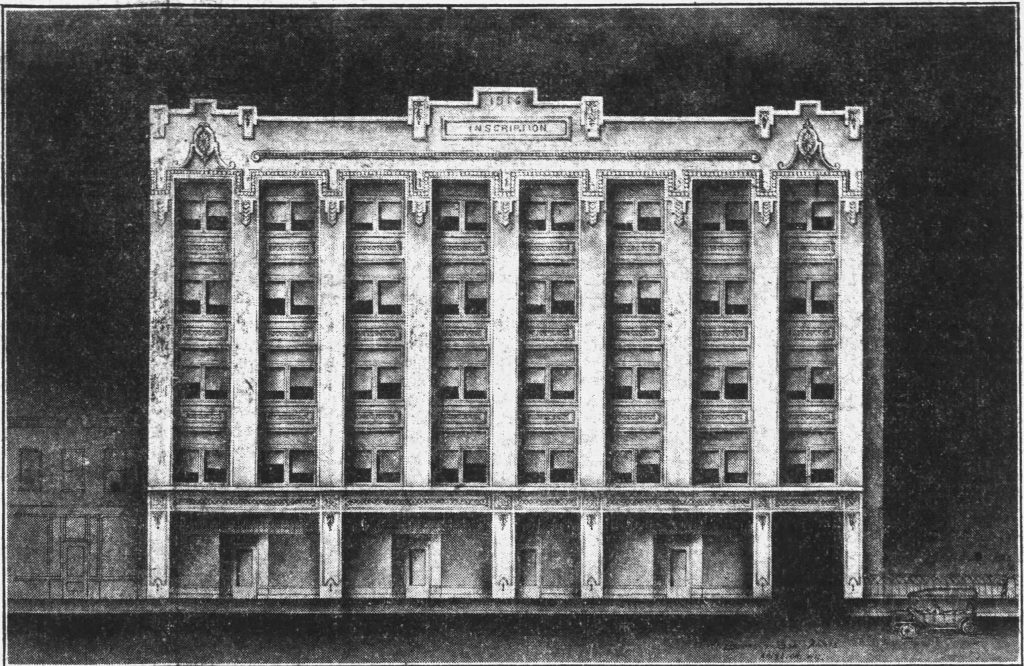
On June 21st for $2,500, the Appleton Ford Company purchased two tracts of land adjoining the land for the new building. This T-shaped piece of property would presumably have been a car lot, with the showroom located on the ground floor of the new building.21
The location of the building was chosen not only for the benefit of the ravine but theproximity to the railway lines. Surveys were run “for the trackage, which will reach the building on the north and west sides,” and the company now awaited “sanction of the city council before going ahead with the actual construction” of the building.22 The plan was to have two Chicago & Northwestern railway tracks “one running along the north side of the building, the other on the west side. Besides these, there will be team tracks on the west side. If the tracks are laid as outlined, one of the cement sheds near the market on Walnut street will have to be removed.” “Mayor Knuppel said…that no decision would be given relative to running the track through the stock fair grounds until an engineer has shown them just what was desired.”23
It is not known whether the city did not approve the petition for a new sidetrack from the C. & N.W. Railway, or the fact that the Chicago and Northwestern Railway failed to build a “much heralded” new freight depot. The new depot had been promised by the railroad for more than two years and was to have been constructed in 1916.24
Whatever the reason, the Anona stockholders decided not to go ahead with the proposed building on College Avenue. Instead, they reversed course and made the decision to move the company to Chicago citing “poor shipping facilities” as the reason for the move and they “expected that better shipping facilities will greatly aid business.”25 Interestingly enough, the Appleton Evening Crescent published an article directly above the Anona announcement titled: “New Freight Depot Now A Certainty” which reported that the plans for the new freight depot were ready, and work would start in the spring.
His young family was settling into life in Appleton, and Hubert decided not to move with the company to Chicago, sending a letter on February 10, 1917, to C. C. Martin in Denver stating his decision and inquiring about disposing of his stock. Martin responded on February 17th, stating that he had forwarded Hubert’s request and decision to the Ingersoll Packing Co. in Canada. He went on to say that the company would prefer the stock be held by the original incorporators, but if not, at the “proper time” it would be “absorbed by those remaining in the company.” Hubert agreed to stay with the company to assist with preparing for the move, which Martin expected to occur “about the last week in March.”26
By the middle of March the new facilities near the Fulton markets, were ready, and the packing of the machinery was completed, ready for the three-day journey to Chicago. Work had already begun in tearing down the plant on West College Avenue.27
On April 18, 1917, following a special meeting of the stockholders, “the articles of said corporation be so amended so as to increase the capital stock of said Anona Cheese Co. from three hundred (300) shares of one hundred ($100) dollars each, to five hundred (500) shares at one hundred ($100) dollars each, so that the authorized capital stock of the corporation shall be fifty thousand ($50,000) dollars; and that the said articles be further amended empowering the said corporation to do business both within and without the state of Wisconsin.” The change was signed by C. C. L. Wilson, President, and J. L. Jacquot, Secretary and Treasurer.28
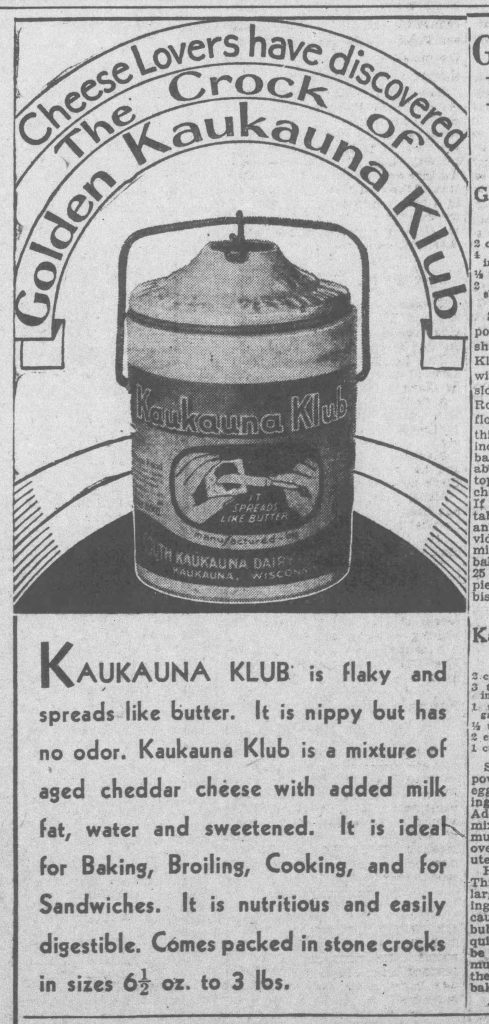
With Anona leaving Appleton for Chicago, Hubert was left without a job. His whole life having been spent in the dairy industry, it is no surprise that 10 months later, in early February 1918, Hubert, his wife, Anna, and Peter Ulmen signed incorporation documents for the South Kaukauna Dairy. The new factory was located in South Kaukauna, Outagamie, Wisconsin, and was incorporated with a capital stock of $10,000.29
Hubert never forgot his short time with Anona. He loved to talk about his years in the milk and creamery business, and area Rotary Clubs were eager to invite him to speak. In April 1929, speaking at the Kaukauna Rotary business meeting, he had this to say: “At [sic] the honor of making the first Anona cheese. This still is being made by that company in Chicago.”30
Two years later on March 2, 1931, Borden Company acquired “the entire assets and business of the Anona Cheese Company of Chicago…”31 The dissolution of the company occurred at a stockholder meeting held in Madison, Dane, Wisconsin. “The firm had 1,000 shares of stock and all voted in favor of the dissolution. Officers of the company were: C. C. Martin, president; and J. F. Tines, secretary.”32 33
And two years after the dissolution of the Anona Cheese Co., Hubert introduced a natural cheese product that “Spreads Like Butter.” He created four flavors: Plain, Chili, Pimento, and Limburger. Coincidence? I personally don’t think so. But that is a story for another day.
Sources
- Thomas H. Ryan, Editor-in-Chief, History of Outagamie County Wisconsin: Being a General Survey of Outagamie County History including a History of the Cities, Towns and Villages throughout the County, from the Earliest Settlement to the Present Time (Chicago, Illinois: Goodspeed Historical Association, 1911), p. 946-947. ↩︎
- “To Make 4,000 Pound Cheese,” Appleton Evening Crescent, 9 Sep 1910, Friday, p. 1, col. 1; digital images, Newspapers.com (www.newspapers.com : accessed 13 Jun 2023). ↩︎
- “Real Estate,” Appleton Evening Crescent, 20 Mar 1915, Saturday, p. 5, col. 5; digital images, Newspapers.com (www.newspapers.com : accessed 3 Sep 2018). ↩︎
- Anona Cheese Company, Corporation Documents, 1915-1931; File no. A 001286, Box no. 0022; Domestic Corporation; Outagamie County, Corporations Index; Wisconsin Historical Society, Madison, Dane, Wisconsin, United States. ↩︎
- Anona Cheese is Now Being Made in City,” Appleton Evening Crescent, 5 Jan 1916, Wednesday, p. 1, col. 7; digital images, Newspapers.com (www.newspapers.com : accessed 3 Sep 2018). ↩︎
- Anona Cheese Company, 1915-1931, Domestic Corporation, Corporations Index, p. 51, 1917 Annual Report. ↩︎
- “$30,000 Cheese Industry Is To Be Opened Here,” Appleton Evening Crescent, 31 Jul 1915, Saturday, p. 1, col. 6; digital images, Newspapers.com (www.newspapers.com : accessed 3 Sep 2018). ↩︎
- “Ruhsam to Occupy New Grocery Quarters,” Appleton Evening Crescent, 18 Aug 1915, Wednesday, p. 1, col. 4; digital images, Newspapers.com (www.newspapers.com : accessed 28 May 2023). ↩︎
- Anona Cheese Company, 1915-1931, Domestic Corporation, Corporations Index. ↩︎
- ”Bluhill Cheese Company Has Changed Its Name,” Appleton Evening Crescent, 16 Dec 1915, Thursday, p. 3, col. 4; digital images, Newspapers.com (www.newspapers.com : accessed 20 Jan 2020). ↩︎
- Ibid. ↩︎
- Ibid. ↩︎
- “Looking Backward. 10 Years Ago,” Appleton Post-Crescent, 13 Jan 1926, Wednesday, p. 4, col. 3; digital images, NewspaperARCHIVE (www.newspaperarchive.com : accessed 2 Feb 2005). ↩︎
- Wisconsin, “Deaths,” 1916, vol. 12, p. 76, Hubert Fassbender, 12 Jan 1916; Register of Deeds, Outagamie County Courthouse, Appleton, Wisconsin, United States. ↩︎
- “Hubert Fossbender Dies of Convulsions Last Night,” Appleton Evening Crescent, 13 Jan 1916, Thursday, p. 1, col. 3. ↩︎
- “Eight Story Building in Ravine a Go,” EXTRA, Appleton Evening Crescent, 5 May 1916, Friday, p. 1, col. 5; digital images, Newspapers.com (www.newspapers.com : accessed 25 May 2023). ↩︎
- “Start Survey of the Track For New Building,” Appleton Evening Crescent, 6 May 1916, Saturday, p. 1, col. 5; digital images, Newspapers.com (www.newspapers.com : accessed 7 Sep 2018). ↩︎
- “Proposed $100,000 Eight Story Building For College Avenue,” Appleton Evening Crescent, 11 May 1916, Thursday, p. 1, col. 4; digital images, Newspapers.com (www.newspapers.com : accessed 26 May 2023). ↩︎
- “Start Survey of Track for New Building,” Saturday, p. 1, col. 5. ↩︎
- “1 2-3 Acres of Space on 4 Floors of Bahcall Building,” Appleton Post-Crescent, 28 Jan 1942, Wednesday, p. 21; digital images, Newspapers.com (www.newspapers.com : accessed 27 May 2023). ↩︎
- Ford Company Buys Ravine Property,” Appleton Evening Crescent, 21 Jun 1916, Wednesday, p. 4, col. 4; digital images, Newspapers.com (www.newspapers.com : accessed 26 May 2023). ↩︎
- “Proposed $100,000 Eight Story Building For College Avenue,” Thursday, p. 1, col. 4. ↩︎
- “Start Survey of Track for New Building,” Saturday, p. 1, col. 5. ↩︎
- “City Impatient at Long Delay,” Appleton Evening Crescent, 19 Jul 1916, Wednesday, p. 1, col. 4; digital images, Newspapers.com (www.newspapers.com : accessed 1 Jul 2023). ↩︎
- “Anona Cheese Co. Moves to Chicago,” Appleton Evening Crescent, 16 Mar 1917, Friday, p. 5, col. 5; digital images, Newspapers.com (www.newspapers.com : accessed 3 Sep 2018). ↩︎
- Letter, Fassbender Memorabilia; privately held by Susan Sternitzky Fassbender, 2012. C. C. Martin to Mr. H. F. Fassbender, 17 Feb 1917. Bernard and Marie Fassbender Family Archives. ↩︎
- “Anona Cheese Co. Moves to Chicago,” Friday, p. 5, col. 5. ↩︎
- Anona Cheese Company, 1915-1931, Domestic Corporation, Corporations Index. ↩︎
- “Cheese Men Incorporate,” The Sheboygan Press, 8 Feb 1918, Friday, p. 8, col. 2; digital images, Newspapers.com (www.newspapers.com : accessed 26 Nov 2017). ↩︎
- “Rotary Club Hears Talk on Creamy Business,” Appleton Post-Crescent, 18 Apr 1929, Thursday Evening, p. 19, col. 2. ↩︎
- “Borden Company Lists Capital Stock Increase,” Poughkeepsie Eagle News, 13 Mar 1931, Friday, p. 9, col. 5; digital images, Newspapers.com (www.newspapers.com : accessed 3 Sep 2018). ↩︎
- “Anona Cheese Co. Quits Business,” Appleton Post-Crescent, 18 Mar 1931, Wednesday Evening, p. 2, col. 1; digital images, NewspaperARCHIVE (www.newspaperarchive.com : accessed 9 Dec 2006). ↩︎
- Anona Cheese Company, 1915-1931, Domestic Corporation, Corporations Index. ↩︎
